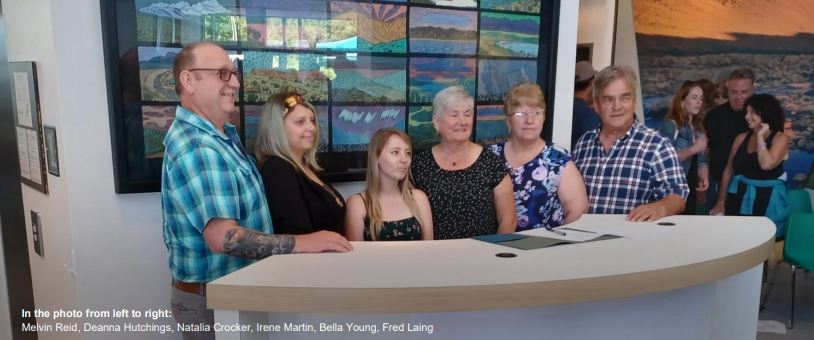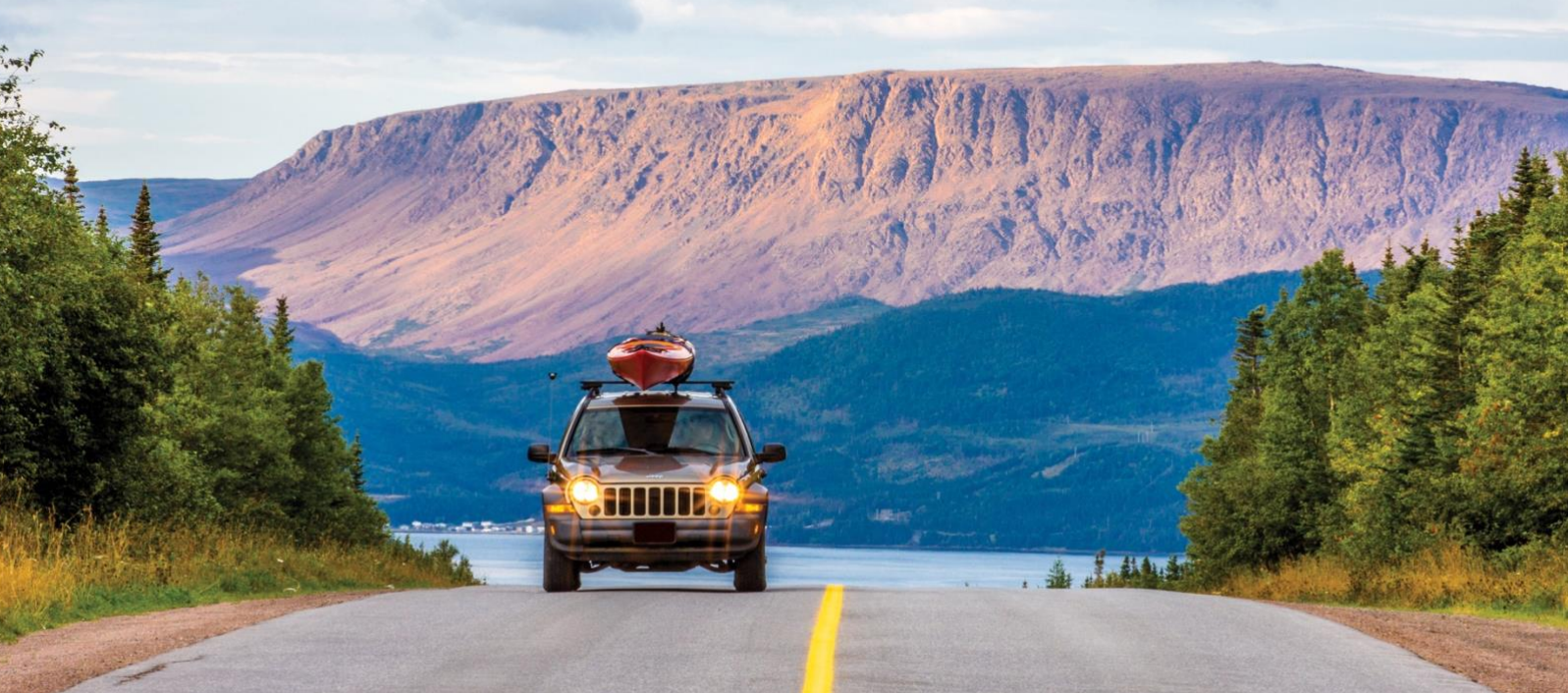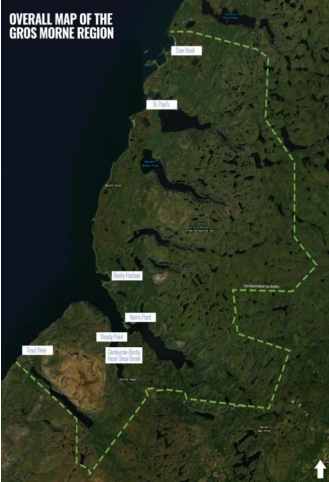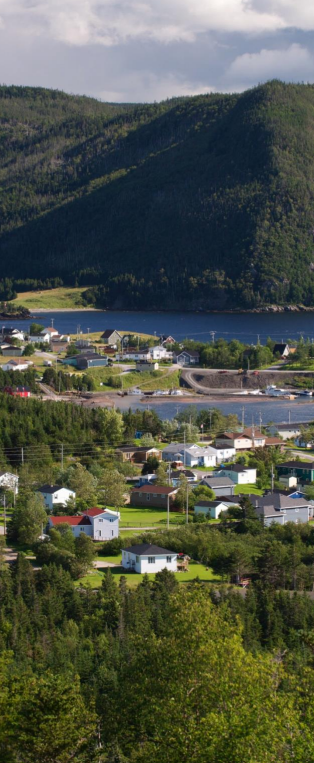Published: January 2024
INTRODUCTION
Located in Canada’s most easterly province Newfoundland and Labrador, the Gros Morne Region has gained a reputation of a majestic and stunning landscape steeped in local history and storytelling. The region is home to Gros Morne National Park which is the second largest national park in Atlantic Canada where tourism is one of the key economic contributors to the area. Seven enclave communities including Cow Head, Woody Point, Trout River, Glenburnie-Birchy Head-Shoal Brook (GBS), Norris Point, Rocky Harbour and St. Paul’s are located in the southern, central and northern portions of the Gros Morne National Park. The area is made up of a cross section of businesses, operators, communities and visitor experiences at various levels of development and the region is rich in history, natural assets and outdoor recreation offerings. Although historical controversy such as the cod moratorium in 1992, the collapse of fisheries and the establishment of the park has pushed communities away from their former economic ways of life towards a dependency on tourism, these communities realized that a focused, regional and collective effort would build capacity overall for the region as well as assist in realizing economic development goals. This case study outlines how collaboration and partnerships have helped identify issues, reconciled differences and strengthened regional tourism initiatives to achieving more sustainable long-term economic growth.
BACKGROUND

There were a number of key issues that affected this region of Newfoundland including resettlement, conflict between the parks and communities as well as the lack of capacity for individual small communities to create long-term tourism development plans and compete for funding. In the 1960’s, the Newfoundland provincial government was struggling to continue adequate level of services to some remote communities, and there was forced resettlement of outport towns by the government. This controversial decision resulted in distrust of government, as well as a lack of support for regionalism and top-down decision making. In 1973, resettlement of some local residents occurred again when Gros Morne National Park was established1 . By 2005, the National Parks Act was applied making it an official National Park but Parks Canada rules and regulations had interfered up until this stage with a way of life that many local residents didn't want to give up. The establishment of the park enforced many bylaws which contradicted traditional ways of life including activities such as hunting, snaring or cutting trees within the boundaries2 .
Although this brought many visitors to the area – approximately 250,000 per year – there was tension between the preservation mandate and local traditions. The region also faced capacity issues. Within the Gros Morne Region, there is no regional governance or most of the towns have a staff of only one or two and municipal governance jobs are essentially volunteer positions. Tourism was not historically a priority or immediate concern as priorities for these small communities tend to be more immediate issues such as ensuring adequate snow removal, garbage, sewage, water supply, roads maintenance etc. The towns needed help to build capacity for tourism including creating a long-term tourism plan, tracking, and identifying funding opportunities, completing funding proposals and, when successful, effectively managing funds e.g., creating Request for Proposals (RFPs) to find contractors and managing active projects. Although there were the best intentions and some local action, there was a need for greater capacity to effectively grow and foster the tourism industry with these communities.
1 Nation, RE (1983) The Acquisition of National Parks: a Challenge for the Future. Dalhousie Law Journal Vol 7(3) Accessed September 2023 from https://digitalcommons.schulichlaw.dal.ca/cgi/viewcontent.cgi?article=1349&context=dlj
2 CBC (2019) An uneasy balance in Gros Morne National Park: A Land & Sea archival special. Accessed September 2023 from https://www.cbc.ca/news/canada/newfoundland-labrador/land-and-sea-gros-morne-1.4831503
THE PARTNERSHIP

The foundation of the current six-community partnership grew out of a project headed up by the Gros Morne Cooperating Association (GMCA). The three-year project (July 2020 – September 2023) was known as the Gros Morne Tourism Regional Implementation Project (GMTRIP). The newly formed partnership has kept the acronym, changing the full name slightly to the Gros Morne Tourism Regional Innovative Partnership. Gros Morne Cooperating Association (GMCA) efforts to work with the communities of Gros Morne aren’t new. Since 1993, this not-for-profit organization has worked with the seven communities, the National Park, as well as many local businesses and other tourism stakeholders to advance tourism in the area, promoting the region to visitors and residents while being committed to communities, the National Park, as well as many local businesses and other tourism stakeholders to advance tourism in the area, promoting the region to visitors and residents while being committed to protecting the natural and human history of the area. In 2017 GMCA hosted a visionary exercise, funded by the Strategic Tourism Areas and Regions (STAR) initiative to develop a 10-year strategic tourism plan for the Gros Morne area.
Their 10-year vision is as follows: Gros Morne Region is internationally sought after as an iconic Canadian travel destination where spectacular nature, cultural expression and authenticity are interwoven to enrich the lives of visitors and residents.3
STAR was developed and funded by the Atlantic Canada Opportunities Agency (ACOA) and illustrates how collaboration of multiple stakeholders can build cooperation.
3 Gros Morne Regional Strategic Plan, 2016. Last accessed September 2023 from https://grosmornecoop.com/wp-content/uploads/FINAL-GMSTAR-Plan-Nov-23-2016.pdf
THE PROGRESS
From the project outset, the communities, ranging in population from 270 residents to 1,000 residents created a working group with the town clerk/managers representing each town. The working group was formed to oversee the project and regular meetings were held to meet specific deliverables. The town clerk/managers were the core of the working group, and they formed a bond over the years as they worked to steer GMTRIP, functioning as something of an extended team. This outcome was the first tangible indicator of the seven towns working with and supporting each other. In addition to this primary working group, GMTRIP created an evaluation committee to develop an evaluation strategy for the project. The evaluation committee included academic advisors and students from Memorial University as well as evaluation experts from ACOA. The evaluation committee undertook a primary initiative to survey residents of Gros Morne communities to establish a baseline of resident opinion, concerns, values and aspirations related to tourism. The results of the survey, conducted from August 6 – October 4, 2021, also provided valuable information for tourism developers and municipal governance by providing a greater understanding of resident opinion re: tourism impacts. Several issues were highlighted including: Need to expand the tourism industry beyond the current 3 month intensity; Concerns re: negative tourism impacts such as driving up real estate costs affecting affordable housing, further intensifying the predominance of an aging population as younger families often cannot afford to locate in the highly desirable tourism communities; Resident expectation that their needs always be a primary consideration in tourism planning to ensure a resilient regenerative approach to tourism.
A new non-binding voluntary partnership agreement was signed on August 13, 2023. This date also marked the 50th anniversary of Gros Morne National Park. Six out of seven enclave communities signed the agreement showcasing that working together is a stronger incentive than operating alone and leads to increased capacity for project management, funding and ownership of projects. The establishment of the six-community partnership also allowed for a shift in direction to focus on overall resilience of the area and adaptability through a participatory approach involving all town councillors (each town elects 7 councillors for a fouryear term). This has ensured greater municipal and political support as well as increasing cooperation between the participating communities. It has also helped develop tools to address and manage issues including branding and marketing but also has morphed away from solely tourism issues to consider external impacts such as climate change and overall regional capacity which also ultimately aids tourism development.
The Regional Partnership consisting of six enclave communities illustrates the following key successes:

REGENERATIVE TOURISM ASPECTS

Over the three-year period of GMTRIP (the project), the working group was recognized by others as a “table” representing the enclave communities and they were approached by others seeking access to the Gros Morne communities. These initiatives were related to tourism and impacted all the communities, including:
Climate Change:
Researchers from Memorial University approached the working group in early 2022 about an initiative to bring knowledge of climate change impacts to the communities4 . This resulted in the GMTRIP working group assisting the researchers to access communities to provide public education.
Another initiative related to climate change, led by AIM (Atlantic Infrastructure Management Network5 ) approached the working group in the fall of 2022 asking for assistance in reaching the enclave communities to enrol them in the AIM initiative which targeted increasing knowledge on climate change vulnerabilities and then assisting communities to plan action to mitigate impacts. Work with AIM continues.
Come Home Year:
Storytelling is a central feature in the tourism infrastructure project that GMTRIP envisions as the first tangible tourism project for the regional partnership. This project, known as “7 Corners”, will see technology-enabled storytelling sites located in each community where visitors can access a unique community view and hear the stories, rooted in the history and people who thrive in these communities. This led the working group to propose a collaborative effort during the ‘Come Home Year’ provincial initiative in 2022 which resulted in a successful funding bid and storytelling events mounted around the Gros Morne area from July – December 2022. This successful “project within a project”6 provided valuable insights and learnings for the GMTRIP (the Partnership) as they continue to plan for their ambitious “7 Corners” project which will draw visitors to communities throughout the Gros Morne area.
4 Maximizing place-based potential: translating interdisciplinary knowledge into climate change action in Gros Morne National Park enclave communities
5 Municipal Asset Management Program, delivered by the Federation of Canadian Municipalities and funded by the Government of Canada.
6 Storytelling CHY Project Report (2022) “Home is where your story began - Come home to Gros Morne we’ve a story to tell”
THE FUTURE
GMTRIP (the project) has reached its conclusion with two key outcomes: the successful creation of a Regional Partnership – Gros Morne Tourism Regional Innovative Partnership, and the development of an ambitious regional tourism infrastructure project – “7 Corners”. In September 2023, the Partnership held their inaugural meeting to establish their board of directors, elect an executive and agree to terms of reference. They identified their immediate and longerterm priorities to pursue incorporation, finalize and submit the proposal to fund the “7 Corners” project, and explore funding opportunities to secure an Economic Development officer for the region. The new GMTRIP (the partnership) celebrated the success of GMTRIP (the project) and acknowledged that the evaluation of GMTRIP’s long-term success will be assessed over time as they embark on their journey to become an effective and productive partnership realizing their goals to:
1. Maintain a regional organization, the Gros Morne Tourism Regional Innovative Partnership (GMTRIP) to pursue tourism economic development in the long term for the municipalities in the Gros Morne region.
2. Work towards closer collaboration among municipal councils with respect to tourism development and promotion.
3. Work collaboratively with the Gros Morne National Park to develop and promote tourism in Gros Morne.
4. Support each other and work together to solve problems as they arise but respect the independence and authority and uniqueness of each municipality.
5. Protect the prized and environmentally significant landscape of Gros Morne, addressing issues impacting tourism including environmental protection and climate change.
6. Grow regional tourism while protecting and enhancing the quality of life for all residents.
7. Invigorate the visitor experience in collaboration with the Gros Morne National Park and the local tourism industry.
Written by:
Rachel Dodds, Sustainable Tourism Expert and Professor at Toronto Metropolitan University.


